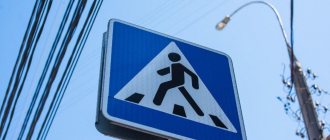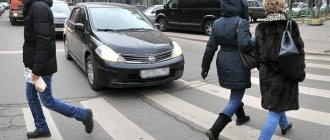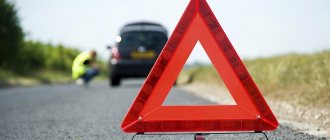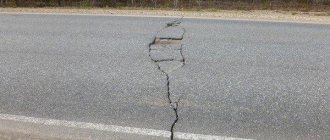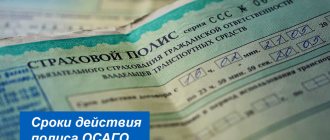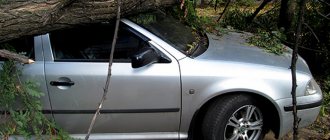An accident also includes an emergency situation—a collision with an obstacle.
The main reason is that the car hits or runs over stationary objects.
The most common of them include:
- plantings near the road;
- building materials;
- fencing;
- bridge supports;
- pillars;
- roadside buildings and various structures;
- the unlocked door of another car.
The danger of such an accident is equal to the consequences of a head-on collision of various vehicles, because As a result, people inside the car may die.
If the driver and passengers did not fasten their seat belts before hitting an obstacle, and the vehicle developed a high speed, then the likelihood of death increases several times.
The concept of “hitting an obstacle”
Registration of an accident for different types of accidents has its own nuances. To understand the intricacies of the type we are considering, let’s study its definition. Hitting an obstacle means an incident when a vehicle runs over or hits an object that is stationary. Most often, drivers hit the following objects:
- pillars by the roads;
- building materials;
- bridge supports;
- fencing;
- buildings along the road;
- car doors left ajar.
The danger level of this act is similar to a head-on collision between cars. Death is also possible here. The risk of death for the driver and passengers will increase if they are not wearing seat belts.
When there is a threat of criminal liability
Hitting an obstacle entails criminal liability for the driver only if, as a result, such actions that caused the accident will pose an increased public danger. In practice, such an offense develops into a crime if harm has been caused to the life or health of people.
The Criminal Code of the Russian Federation provides for articles 264 and 266 for violating the rules of vehicle operation and traffic rules, which results in grave consequences. Accordingly, for criminal prosecution it is essential to identify the reasons why the person committed the collision.
For example, if the person was sober, then for harm to a person’s health as a result of a collision they will be given no more than two years, but if alcohol intoxication was recorded, then up to four years.
If the accident resulted in the death of a person, then the specified periods will increase to five and seven years, respectively. When several people were injured at once (two or more), the punishment will be seven and nine years. In addition, the driver will be prohibited from driving a car for a maximum of three years.
Payments for fatal accidents.
Who to sue in case of an accident, the culprit or the owner, read here.
What to do if, after an accident, the insurance company sued me for damages, read the link: https://novocom.org/straxovanie/straxovaya-podala-na-menya-v-sud-po-dtp-na-vozmeshhenie -ushherba.html
What does a minor event mean?
Practice also knows cases when, even when hitting a stationary object, a person is not held accountable, since the offense is of minor significance. The criteria for insignificance are determined by the Supreme Court of the Russian Federation by Resolution No. 5 of 2005.
Acts that formally presuppose the establishment of elements of an offense, but due to the nature of the public danger, do not pose a threat and do not harm any social relations, are recognized as minor. Consequently, insignificance is determined by the nature of the act, regardless of whether it is an action or an inaction, which is formally recognized as a violation of the law.
Determination of fault in an accident.
Arbitrage practice
- Resolution No. 4A-492/2017 of the Arkhangelsk Regional Court on the application of paragraph 10.1 as a violation that led to a collision with a standing car.
- Decision No. 12-57/2014 of the Kirov District Court cancels the decision to refuse to initiate proceedings for violating paragraph 10.1 of the traffic rules, which led to an accident, since the accident was caused by a violation of the traffic rules of the second participant.
- Decision No. 12-312/2013 of the District Court in Vladivostok refusing to satisfy the applicant’s complaint on the basis that he was charged with a violation of paragraph 10.1, but he could not foresee the danger to traffic due to ice, with reference to the fact that areas of ice must be indicated by appropriate road signs.
Rules for registering an accident without the police in 2020: the subtleties of the European protocol
At the same time, everyone should be aware that according to the European Protocol, the party injured as a result of the collision will receive an insurance payment not exceeding 100,000 rubles; 7) the question of who is at fault for the accident and who is the victim has been resolved peacefully.
2) if people were injured in the accident. In such a situation, the involvement of the traffic police is mandatory.
What should you do after getting into an accident?
2) Install an emergency sign.
Perhaps this, as well as the increase in insurance payments from July 2015, will tip the scales in favor of the European protocol.
Participants in an accident can use the European protocol if the circumstances of the accident are as follows:
- No people were hurt.
- Only the vehicle was damaged (no other material damage was caused).
- The liability of both drivers is insured under MTPL or the international Green Card policy.
- Two vehicles collided.
- The drivers have no disagreement about the damage and circumstances of the accident.
According to the standards of the European protocol, if one of the listed conditions is violated, it is necessary to call the traffic police.
According to Article 1.11 of Federal Law No. 40-FZ of April 25, 2002, there are a number of mandatory conditions for registering an accident under the European protocol:
- There were no injuries, including pedestrians and passengers.
- No more than two vehicles, including vehicles with trailers, are involved in the accident.
Contrary to information spread on the Internet, a car with a trailer in this case is considered as one vehicle.
- Both drivers have valid MTPL policies or a “Green Card” for foreign cars.
- The list of damages, degree of fault and other circumstances of the accident do not cause disagreement.
In addition, the alleged damage must be within the limits on the amount of insurance compensation.
The amount of payments is established by the same law: If you get into a traffic accident, you must stop, turn on the hazard lights and put up a warning triangle.
In addition, you need to remember that compensation under the European protocol has limits. Let’s imagine a situation that satisfies all the conditions for independent registration.
We have a document in front of us that needs to be filled out. Let's first consider the general points about it.
We have already briefly examined the conditions under which a European protocol is issued in case of an accident. Let us highlight their features. You need to understand that any, even minor, errors when filling out can cause refusals under the European protocol from insurance companies.
I say I pay only 1500 and only if you later include this amount in the repair bill.
OK! They took the car, paid, and gave me a piece of paper: 1. Show the car insurance again 3. Do an independent examination 5. File a lawsuit against the person responsible for the accident, since there is no way to get around the 50 thousand limit, even with photos. And this Hemorrhoid will happen, taking into account the fact that my new car was smashed, it was broken quite well, I will have to prove my case and run through the courts, I cannot repair the car until the end of the trial and, accordingly, make full use of it.
Is it a traffic accident or not?
Hitting an obstacle is an emergency situation that is classified as an accident. The main cause of accidents is that a car hits an immovable object. An accident is subject to registration in accordance with the rules established by law.
Does CASCO cover it?
The easiest and most convenient way in such a situation is for drivers who have a CASCO policy. Insurance covers most of the damage. But to receive a compensation payment, it is necessary that the owner of the car has an understanding of the intricacies of the contract. Advice! CASCO policies are convenient because in order to receive compensation from the insurer, you may not even need a certificate of the accident that occurred. Sometimes the company refuses to pay the policyholder. Refunds for repairs are refused in the following cases:
- At the time of the incident, the driver was intoxicated.
- The person driving the car involved in the accident is not included in the insurance.
- According to the contract, the accident cannot be considered an insured event.
- The insurer receives the claim with a long delay.
Do I need to call the traffic police?
According to the law, an accident can be registered both without traffic police officers and with their direct participation . If there are no more than two victims in the accident, they have civil liability insurance, they have no claims for damage to property, and you can register the incident yourself.
If only one driver was involved in the collision, you must call a traffic police representative.
Actions in case of an insured event
What the victim should do immediately after the accident is set out in Art. 11 of the law on compulsory motor liability insurance:
- Act in accordance with traffic rules.
- Inform other participants in the incident your policy details and obtain information about their compulsory motor liability insurance (numbers, names and details of the insurance company).
- Get a certificate about the accident.
- Notify the insurer about the insured event and act according to its instructions.
- Collect a package of documents, write an application and send it to the Investigative Committee.
- Wait for the decision on reimbursement.
Today you can file an insurance claim without the traffic police - if the damage is small and the participants were able to come to an agreement. A European protocol form (notification of an accident) is issued along with the policy. Filled out by hand on the spot. Together with the necessary documents, it is sent to the insurer within 5 days.
Within 10 days from the moment of the accident, the damaged car must be presented to the insurer for inspection and examination. That is, it cannot be repaired for the first 15 days after the incident.
Design methods
Registration of an accident, as in standard cases, can be carried out with the involvement of traffic police officers or without calling them.
With traffic police officers
The inspector called to the scene collects the following information:
- Driver information;
- Explanations of the participants in the accident;
- Witness statements;
- Type of accident;
- List of damage received.
Based on the information received, the inspector draws up a list of documents:
A report of the inspection of the scene of the incident, which indicates information about the road section, characteristics of the roadway, the presence of pedestrian paths and road surfaces. The report also includes information about weather conditions at the time of the accident. The document states:
- Start and end time of inspection;
- Distances and measurements that will be taken into account during further investigation;
- Actions to record the situation of an accident;
- Statements from participants in the incident.
Certificate of road accident in the form of Order of the Ministry of Internal Affairs of Russia dated April 1, 2011 No. 154. It contains information about:
- The exact time and date of the incident;
- Participants in the incident;
- Injured;
- License plates of the vehicle;
- Damage to cars.
Road accident diagram, which describes the circumstances of the accident and explanations of the participants. It states:
- Measuring the position of a vehicle that has hit an object;
- Impact objects;
- Length and direction of braking distance;
- Dimensions of nearby objects;
- Graphic diagram of the collision location with explanations;
- Factors limiting the review;
- Auxiliary landmarks;
- Dimensions of objects perpendicular and parallel to the road line;
- Characteristic points of the vehicle (wheel hubs and/or tow hooks).
Protocol of inspection and technical condition of the machine - faults are noted, indicating the degree of deformation. Protocol for monitoring driver sobriety based on the results of a breathalyzer test.
No employees
Registration of an accident without calling the police is possible only if the accident involved 2 vehicles, the drivers of which have no claims against each other and both have a valid MTPL policy. If only one person was involved in the accident, calling an inspector to register the incident is mandatory.
Main causes of the incident
Collisions with obstacles have different causes, the most common of which are:
- speeding, failure to use seat belts, operating a faulty vehicle, driving while intoxicated and other traffic violations;
- smoking while driving or eating;
- driver fatigue;
- loud music in the cabin;
- simple carelessness;
- talking on a mobile phone while driving;
- or difficult weather conditions.
The definition of “hitting an obstacle” means some kind of incident in which a specific car ran over or collided with one or another static object. Such objects can be trees, fences, road poles or supports, buildings, structures, structures located near the road, other vehicles, construction materials, etc. According to statistics, the main causes of such road accidents are:
- Violation of traffic rules, including drunk driving, use of an unauthorized vehicle, etc.;
- Poor health or overwork of the driver;
- Inattention when moving;
- Unfavorable climatic conditions, including rain or snow;
- Smoking, eating, talking on the phone or other distractions while driving.
In practice, other factors may also be the cause of a traffic accident of this nature. The severity of the consequences also depends on several conditions - the speed of the vehicle, unfastened seat belts, etc.
The main reasons why a driver hits an obstacle are the following.
- Violation of traffic rules, especially in terms of exceeding the speed limit, driving while intoxicated, failure to use seat belts, driving with a faulty car.
- Eating or smoking while driving.
- Inattention.
- Overwork.
- The sound of loud music.
- Bad weather.
We invite you to familiarize yourself with: Registration of ownership of an apartment with a mortgage: registration procedure, necessary documents
Official interpretation for 2021
10.1. The driver must drive the vehicle at a speed not exceeding the established limit, taking into account the intensity of traffic, the characteristics and condition of the vehicle and cargo, road and meteorological conditions, in particular, visibility in the direction of travel. The speed must provide the driver with the ability to constantly control the movement of the vehicle to comply with the requirements of the Rules.
If a traffic hazard arises that the driver is able to detect, he must take possible measures to reduce the speed until the vehicle stops.
About payments under compulsory motor liability insurance
Insurance companies are now not obliged to compensate for damages with money. In what case of payment and in what case of repair, the insurer decides - independently or with the insured. Typically, a decision on payments is made if:
- The vehicle was completely destroyed.
- The cost of restoration exceeds the legal limit, but the owner does not want to pay extra.
- The insurer cannot arrange repairs.
Only the owner of the car or his authorized representative can receive payment or a referral for repairs. The victim will be compensated for damage through the Russian Union of Auto Insurers (RUA) if:
- The insurance company went bankrupt/lost its license;
- the culprit has not been identified, is not insured, or does not have the right to drive the car.
Payment terms should not exceed 20 or 30 days if the victim, upon written request, organizes repairs on his own. The decision on compensation may be delayed indefinitely if the incident is under criminal investigation or the culprit is being sought.
An insurance event report under compulsory motor liability insurance, if necessary, will allow you to prove the fact of the occurrence of an insured situation and the procedure for calculating compensation. At the request of the policyholder, the document is issued within 3 days.
Out of nowhere - an accident hitting an obstacle
You can register an accident yourself.
To do this, you must fill out a form that states:
- the amount of damage incurred as a result of the accident;
- circumstances of the accident;
- information about the injured person (full name, passport details, address, telephone);
- road accident diagram with a detailed description.
Possible consequences of this accident: Knowledge of all the above nuances will help you quickly navigate and act correctly when hitting an obstacle!
To receive compensation under comprehensive insurance, the European Protocol may not be enough, check with your insurance company.
- The accident location was recorded using the GLONASS system (note that GPS will not work).
- there are photographs from the scene of the incident (possibly video);
If nothing changes in the law, from October 2021 this norm will be in effect for all regions.
How is the Europrotocol drawn up?
When registering an incident without calling the police, participants independently fill out an accident notification form, which is sent to the insurance company. It is necessary to reflect:
- Circumstances of the accident;
- Scheme of the incident;
- The nature of the damage and its extent.
Despite some advantages of completing the Europrotocol yourself (first of all, saving time), it is still advisable to spend several hours meeting with traffic police officers, because the latter will be able to more competently reflect all the circumstances of the case.
○ Advice from a lawyer:
✔ If a collision with an obstacle occurred due to the fault of the driver who cut off the car, who will be held responsible?
In this case, the driver who created the emergency situation must be punished, because it is he who is the culprit of the accident. The fact of his guilt and punishment are determined by the court.
✔ Is it possible to avoid litigation if you repair the vehicle yourself?
This is possible because in such a case the victim will have no reason to complain. His main goal is to compensate for the damage, and who will do this, the culprit or the insurance company, does not make a significant difference for him.
Blog “OUR SUPERVISION”. In this video you will learn how to file an accident when you hit an obstacle.
Published by: Vadim Kalyuzhny , specialist of the TopYurist.RU portal
The number of road traffic accidents is growing every year; one of the most common accidents is hitting an obstacle. Registration of an accident in this case in accordance with the requirements of the law is an important condition for obtaining compensation for damage caused.
What is the penalty for non-compliance with 10.1
There is no specific penalty for this. The text of the Code of Administrative Offenses does not contain penalties for incorrectly chosen speed due to road conditions or weather. Fines for speeding can be found in Art. 12.9. However, when drawing up a resolution, clause 10.2 of the traffic rules is automatically violated, and not 10.1.
But the last point is often used in accidents when the driver, for example, stopped at the wrong time and crashed into an obstacle, regardless of whether he was speeding or not. There is usually only one solution in such accidents: you didn’t have time to brake, which means you didn’t maintain a safe speed on the road, and violated clause 10.1.
Bringing the offender to justice
If there are all the signs of an offense, the person driving the vehicle may be held accountable. Despite the fact that there is no specific article providing for punishment under the Code of Administrative Offenses, the violator may face a fine for general non-compliance with the Rules, which resulted in a collision.
For example, if the operation of a car was prohibited, then the violator will face one fine. If you don't use seat belts - another one. For drunk driving - the third, and so on.
In some cases, criminal liability may be provided for the offense. It occurs if the obstacle that the driver ran into poses a high public danger.
As a rule, in this case, the crime leads to victims: dead or injured. Hitting an obstacle that is in a stationary state may be a violation of the rules. The offender faces two years if the act was committed through negligence, but resulted in harm to health, for example, led to loss of vision, hearing, injury, etc.
If the incident ends in death, then imprisonment will last up to 5 years, and in the case of drunk driving - up to 7 years. If the Rules are violated, resulting in the death of two or more people, the violator will be punished with imprisonment for up to 7 years, and if he was drunk - up to 9 years.
In addition to this punishment, you will be prohibited from driving a car for up to 3 years if the crime was classified as hitting an obstacle.
The Code of Administrative Offenses does not have a separate regulatory act establishing liability for hitting a stationary vehicle or a stationary object, since the severity of the punishment depends on the accompanying circumstances: whether the driver’s seat belts were fastened, whether the speed was exceeded, whether traffic rules were followed, etc.
An administrative penalty is provided for hitting a standing obstacle, since the driver must maintain a distance in order to reduce speed in an unforeseen situation, avoid a collision or stop the car. The fine ranges from 1000 to 1500 rubles under Article 12.15 of the Code of Administrative Offenses of the Russian Federation.
A traffic accident does not necessarily mean a collision between two cars. Sometimes this may be a collision with an obstacle, which is also regarded as an accident and requires drawing up a report. In today’s article, we’ll look at the characteristics of such incidents and how the driver should act to resolve the situation as painlessly as possible.
One of the variants of an accident is a collision with a stationary object that the driver ran into or collided with. Most often, the objects of collision are:
- Bridge supports.
- Roadside pillars.
- Trees growing along the highway.
- Construction materials (sand, crushed stone, bricks, etc.).
- Fencing (for example, about carrying out repair work).
- Buildings and other structures located along the road.
- Doors of another vehicle left ajar.
In terms of the degree of danger, hitting an obstacle can be compared to a head-on collision between two cars, because in both cases injuries and even death are possible. The risk of death for a driver or passenger increases if they are not wearing a seat belt when they collide with an obstacle.
Registration of an accident, as in standard cases, can be carried out with the involvement of traffic police officers or without calling them.
The inspector called to the scene collects the following information:
- Driver information.
- Explanations of the participants in the accident.
- Testimony of witnesses.
- Type of accident.
- List of damage received.
Registration of an accident without calling the police is possible only if the accident involved 2 vehicles, the drivers of which have no claims against each other and both have a valid MTPL policy. If only one person was involved in the accident, calling an inspector to register the incident is mandatory.
When registering an incident without calling the police, participants independently fill out an accident notification form, which is sent to the insurance company. It is necessary to reflect:
- Circumstances of the accident.
- Scheme of the incident.
- The nature of the damage and its extent.
Despite some advantages of completing the Europrotocol yourself (first of all, saving time), it is still advisable to spend several hours meeting with traffic police officers, because the latter will be able to more competently reflect all the circumstances of the case.
We invite you to familiarize yourself with: Assignment agreement and its possibilities under the Civil Code of the Russian Federation
You can and should contact the insurance company with a drawn up European Protocol or an accident notification issued by an inspector. The documents must be submitted to the insurance company no later than 5 days after the incident. But to maximize your chances of receiving compensation, it is advisable to notify the insurance company immediately on the day of the accident.
The damage assessment is carried out by an expert from the insurance company that issued your policy. Such a study is necessary in order to calculate the cost of compensation that will be paid to the driver. The examination is carried out at the expense of the insurance company and will be free for the client.
If any problems arise (for example, the insurance company assigns too little compensation), you can make an independent examination and demand compensation in the required amount. To do this, you can contact the emergency commissioner, who can be an individual or legal entity whose services drivers use in case of controversial insurance situations.
Avarcom works only for CASCO users; its services are not available for OSAGO holders. The cost of his services, as a rule, is already included in the policy, so calling him will not incur additional costs.
The Code of Administrative Offenses does not have a separate article regulating the punishment for hitting an obstacle. Such an offense is classified as failure to comply with traffic rules resulting from a collision. The punishment depends on the reasons that led to the collision.
The use by a driver while a vehicle is moving of a telephone that is not equipped with a technical device that allows hands-free negotiations shall entail the imposition of an administrative fine in the amount of one thousand five hundred rubles. (Article 12.36.1 of the Code of Administrative Offenses of the Russian Federation).
Here you need to take into account that the driver will be held accountable if the obstacle that was hit was installed in accordance with all the rules of the law. If there are violations, the owner of the item will be punished.
Failure to comply with requirements for ensuring road safety during the construction, reconstruction, repair and maintenance of roads, railway crossings or other road structures, or failure to take measures to timely eliminate obstacles to traffic, to temporarily restrict or stop the movement of vehicles on certain sections of roads in cases if the use of such areas threatens road safety, entails the imposition of an administrative fine on officials responsible for the condition of roads, railway crossings or other road structures in the amount of twenty thousand to thirty thousand rubles; for legal entities - from two hundred thousand to three hundred thousand rubles. (Clause 1 of Article 12.4 of the Code of Administrative Offenses of the Russian Federation).
If harm to health is caused to a mild or moderate degree, the fine increases to 50-100 thousand rubles for individuals and 400-500 thousand for legal entities.
The guilt of the road services is determined by the traffic police officer, it is recorded in all protocols. Prosecution is carried out through the court.
For example, if construction materials are located in a travel area and are not protected by warning signs, their owner is responsible for the accident. The severity of the punishment depends on the severity of the accident.
Colliding with a stationary object is usually an insured event under CASCO. Therefore, you can count on compensation in the event of a collision. Most companies provide the possibility of paying compensation for minor damage. But many of them find completely legal ways to avoid transferring funds.
For example, you call your insurance company after an accident and describe the situation. At the other end of the line they assure you that your case is on the insurance list and offer to come for registration. You, happy that you don’t need to collect a bunch of papers, go to the company, write a statement, to which you are told that they will not pay you anything.
Thus, hitting a stationary object is a type of accident, which has its own characteristics and nuances. Knowing them will help you get compensation after an accident and get out of the situation with minimal losses.
There are different ways to hold a driver accountable for a hit-and-run. The law provides for three types of liability.
Criminal penalty
Of course, only an offense with a high public danger can be a reason for criminal prosecution. This also applies to drivers who hit an obstacle.
In order for there to be grounds for prosecution under an article of the Criminal Code, such an act must result in serious bodily injury or death of a person. As for the actual punishment for hitting, its degree is determined by Art. 264 and 266 of the Criminal Code of the Russian Federation.
As noted above, collisions most often occur due to traffic violations. And if such a violation was committed through negligence (but resulted in serious harm to health), the culprit can “get off” with 2 years of imprisonment by a court decision.
If the victim dies as a result of the collision, the offender can go to prison for up to 5 years. And if the driver is found to be under the influence of alcohol or drugs - up to 7 years. If 2 or more people die after a collision, the offender may be sentenced to imprisonment for up to 7 years. And in case of aggravating circumstances (we are talking again about alcohol or drugs in the blood) - up to 9 years.
What awaits the car owner who left the scene of the accident?
If the driver, whose car crashed into a tree, bridge, pole or any other obstacle, ignores these instructions of the law and leaves the scene of the accident, and the police find out about this incident, the driver of the car will most likely be brought to administrative responsibility under Part 2 of Art. 12.27 Code of Administrative Offenses of the Russian Federation.
REFERENCE! According to Article 12.27 of the Code of Administrative Offenses of the Russian Federation, punishment is imposed in the form of deprivation of rights for a period of 1-1.5 years; in another case, administrative arrest of the culprit of the accident is provided for for a period of up to 15 days.
When to apply for funds?
It is advisable to contact an insurance service employee immediately after an accident to notify him of the incident. Only 5 days are given to provide this information. If you apply for insurance after this period of time, the car owner will have to go to court.
If you have the necessary documents, you can count on insurance for two years after the accident. After this time the policy is cancelled.
If any problems arise (for example, the insurance company assigns too little compensation), you can make an independent examination and demand compensation in the required amount. To do this, you can contact the emergency commissioner, who can be an individual or legal entity whose services drivers use in case of controversial insurance situations.
Avarcom works only for CASCO users; its services are not available for OSAGO holders. The cost of his services, as a rule, is already included in the policy, so calling him will not incur additional costs.
Registration of an accident with a traffic police officer
The incident can be registered with or without a traffic police officer. In the first case, the inspector, having arrived at the scene, becomes familiar with the circumstances that led to the violation. At the same time, it collects the following information:
- finds out the driver’s last name, first name, patronymic, as well as his address and telephone number;
- listens to the explanations of the culprit, other participants and eyewitnesses;
- determines the type of traffic accident;
- records all damage received by the car when it collided with an obstacle.
We invite you to read: Hiring during maternity leave
An employee registers an accident by compiling and collecting the following documents:
- Road accident diagram. This is the first document that is recorded at the scene of the incident. It displays precise measurements of the position of the car, objects of impact, the direction of the braking distance, a description of objects located nearby with an indication of their sizes, a graphic image, a description of what limited the driver’s visibility, objects located perpendicular and parallel to the axis of the road with an indication of their sizes, points of the car , namely wheel hubs and tow hooks.
- Explanations of the driver, passengers and eyewitnesses. In them they describe everything that they saw when the accident happened, or did not see and could not see.
- The employee also fills out a certificate, which he issues to drivers, although it may be given with a delay. This document displays information about the time of the incident, participants, license plate numbers, victims and damage to the vehicle.
- Protocol of inspection of the scene of the incident. It must display the area where the collision occurred, indicating the nearest streets. The shape and size of the road are also indicated. The inspector must record, if any, road markings, signs and traffic lights, as well as signs. The protocol should contain information about the pedestrian path, trees, garages, kiosks and other objects nearby. The road surface, holes, bumps and unevenness are described. The protocol should also reflect the weather and visibility conditions at the time of the inspection. It clearly indicates the time of the inspection, all measurements relevant to the investigation of the collision with an obstacle, items seized as evidence, tread prints, recordings from a video recorder or security camera, all statements from participants in the accident and eyewitnesses.
Features of registration of an accident when hitting an obstacle include a mandatory inspection and drawing up a report on the technical condition of the car. It should describe in detail whether there were any malfunctions for which the driver did not have the right to drive the vehicle, since perhaps this was the reason that the collision with an obstacle occurred (hull insurance for an accident of this kind may not be paid in such a case). case).
A sobriety control protocol is also filled out. If necessary, the inspector delivers the driver to the examination site. Then, based on it, the narcologist fills out a report on the driver who hit the obstacle.
Last modified
Clause 10.1 has not changed since the introduction of the Road Traffic Rules as a by-law until 2021. The above interpretation has been sounding this way since 1993.
The only attempt to change this clause of the by-law was in public initiative No. 77F12974, where the initiator indicated that 10.1 actually introduces a presumption of guilt of the driver in its last paragraph, and justifying this by the fact that, for example, even in an accident with a pedestrian crossing the roadway in a prohibited in place of a prohibiting traffic light and even in a state of intoxication, the driver is still charged with a violation of 10.1 and is made guilty.
The initiative was not accepted for consideration due to the small number of voters.
Rules for drawing up a protocol
To receive insurance payment under a comprehensive insurance policy, the car owner will have to use the help of traffic inspectors. For this, it is important to correctly register a collision with an obstacle. The procedure can be performed not only by traffic police officers, but even independently if the driver knows well what actions he must perform.
Most often, citizens prefer to contact a traffic inspector for registration. Under such conditions, traffic police officers arrive at the scene of an accident. Hitting an obstacle is considered a fairly simple incident to report, but the traffic inspector must receive maximum information about it:
- clarifications are taken directly from the culprit of the accident in order to identify the cause of the collision;
- the information received is compared with the explanations of eyewitnesses, if any;
- the type of accident is determined;
- All damage caused to the vehicle is assessed.
Based on the information received, the traffic police officer creates an accident report. Additionally, a certificate of the incident and an accident diagram are drawn up. A report is made of the inspection and technical condition of the vehicle. A medical examination is carried out using a breathalyzer, which allows you to determine what condition the driver was in during the accident.
Only if you have comprehensive insurance can you count on insurance payments if you hit an obstacle. Registration of an accident under such conditions must be competent. Typically, drivers prefer to address this issue to traffic inspectors.
The traffic police officer must create a report of the incident. This document must contain certain information, which includes:
- indicate the name of the road section where the accident occurred;
- the shape and size of the road is given;
- existing signs and markings are registered;
- the traffic lights or signs installed nearby are listed;
- a lot of attention is paid to various additional objects, which include buildings, trees or other elements on or near the road;
- provides data on weather conditions and visibility during the accident;
- indicates in which direction and at what speed the car was moving before the incident;
- the time and place of inspection of the driver and the car is indicated;
- items seized by the traffic inspector at the scene of the incident are listed;
- information about the actions performed by the traffic police officer is entered in order to correctly draw up an accident diagram.
Attached to this document are statements received from the direct driver, existing victims or witnesses. In this case, the motorist must be held administratively liable for hitting an obstacle. Traffic regulations clause 9.10 is considered the most common in such protocols, since such incidents often occur due to the incorrect location of the car on the roadway.
We suggest you read: Determine the insurance policy by the state number of the car
The traffic inspector must attach a diagram to the certificate. Only if you have all the necessary documents can you count on comprehensive insurance payments for hitting an obstacle. Clause 9.10 of the traffic rules indicates that such an incident must occur with a real estate object, which must be confirmed by a diagram drawn up by the traffic police officer.
When creating this document, the following information is entered into it:
- the position of a car that has hit a stationary element on the road;
- both objects are described;
- the direction of movement of the vehicle and the length of the braking distance are indicated;
- all objects located near the accident site are described;
- a graphic image of the accident is made, to which an explanatory note is attached;
- various additional factors are described;
- signs, signs or other elements available on this section of the road are listed.
Additionally, a protocol for inspection and testing of the machine is drawn up. These documents list the malfunctions and damage to the vehicle. All these documents are submitted to the insurance company to receive compensation.
For hitting an obstacle, you can only count on compensation from the insurance company if you have a comprehensive insurance policy. Payments are awarded only on the condition that the driver has complied with certain requirements set by insurance companies. This includes the procedure for registering an accident and the time frame within which a citizen applies to the insurance organization.
Compensation will be denied if the following conditions are met:
- the driver sent knowingly false information about the accident to the company, and the company not only cancels the insurance, but can also sue the client, and the citizen is also blacklisted;
- transferring fake documents to the organization, and under such conditions the driver may even be subject to criminal liability.
Not only the car owner, but also people injured as a result of this accident can count on payments. Companies independently conduct a competent examination of the car to ensure that there is no fraud on the part of car owners.
Compensation is awarded even for minor damage. To do this, it is important for the car owner to submit to the insurance company the necessary documents drawn up by the car inspector.
The car owner may be denied insurance benefits if he was intoxicated or using drugs at the time of the accident. If there is evidence that a person intentionally drove into an obstacle, then he will also not receive funds from the insurance company.
Compensation under CASCO
Even in the event of a collision with a stationary object, and such an event is recognized as an offense, motorists can cover damage to the car resulting from the collision. To do this, you need to apply for CASCO insurance. However, not every case under the contract will involve compensation for damage and insurance payment.
Practice shows that in most cases the owner of a CASCO policy receives compensation for damage that was caused as a result of the road accident in question. Only in exceptional cases under CASCO must a motorist present a certificate of accident, which also simplifies the procedure for receiving money.
applications for insurance payment under CASCO free in word format
Please note! Some circumstances lead to the fact that the insurance company refuses to pay insurance to a person, this happens in the following situations:
- The collision was carried out by a driver who, at the time of driving, was in a state of alcohol or other intoxication,
- At the time of the traffic accident, there was a person driving the car who was not authorized to drive. The ability to drive a car is determined by the presence of a specific person’s name in the insurance policy,
- An insured event, namely a collision with a stationary object, is not provided for in an agreement with the insurance company, which is rare,
- A motorist involved in an accident contacted the insurance company too late to receive benefits.
When contacting an insurance company, you need to carefully study the CASCO agreement, initially not expecting to receive a payment, because insurers are trying in every possible way to avoid obligations to compensate for damage caused during a road accident.
ATTENTION! View the completed sample application for insurance payment under CASCO:
Watch the video. Refusal to pay MTPL and CASCO insurance. What's legal and what's not?
If the insurance company refuses to pay
If the insurance company has no legal grounds to refuse payments, it is first necessary to obtain written confirmation of the refusal. And then - influence the insurer using legal methods in order:
- Send a complaint to RSA or the Bank of Russia.
- File a lawsuit in the district court at the location of the insurance company.
If the refusal is found to be unfounded, the insurer will be required to pay compensation. Moreover, he will also pay a penalty (1% of the insured amount) and a penalty (0.05% per day of delay).
conclusions
Finally, a few words about compulsory insurance. It is, of course, far from perfect, but still saves in many situations. And besides:
- Although a specific list of insured events is not fixed by law, the list of situations when insurance companies can refuse compensation for damage under compulsory motor liability insurance is not so long.
- If you have an additional agreement, you can receive payments for an insured event not related to an accident.
- The policy is valid in courtyards and parking lots if it is proven that a traffic accident has occurred.
- When an insured event occurs, it must be properly documented and promptly notified of the incident to the insurance company.
- You can challenge the insurer’s refusal to pay or their amount in the RSA, the Bank of Russia or the court.
